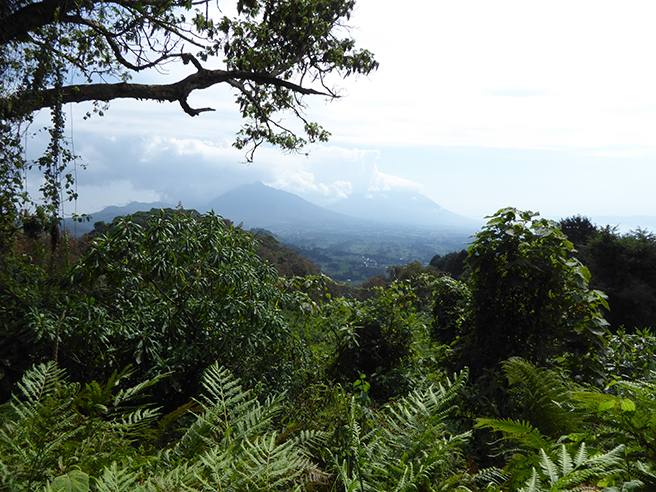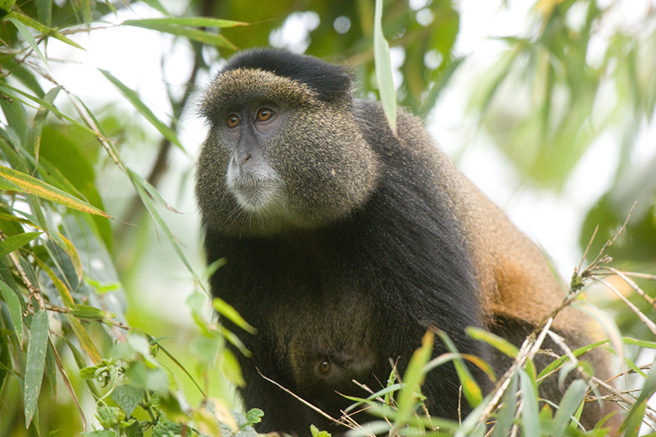The Volcanoes of Rwanda

As we climbed out of Kigali on to one of the ridges leading north-west to the Volcanoes National Park area I was surprised to see the lush, green landscape spreading out across the ridges and valleys way into the distance. This landscape contrasted dramatically with northern Botswana where I have just spent three weeks—where it is dry, dusty and sandy with sparse vegetation except along the rivers.
The other thing that surprised me was the intense patchwork of small fields cultivated with sorghum, chillies, and beans and at higher altitudes Irish potatoes (as they are known here). This intense cultivation reflects Rwanda’s high population density of 477 people per square kilometre. Compare that with the USA of 35 and Australia of 3.
Following a two-hour drive through this lush agrarian landscape we arrived at Musanze (formerly known as Ruhengeri) where I will be based for the next three weeks. I settled into my hotel room, which is quite luxurious with Internet access, TV and a fridge. Called Best View Hotel is offers great views of the Virunga Range of volcanoes that stretch into the Democratic Republic of Congo and Uganda. The scenery is stunning; though often the volcanoes are cloaked in mist and cloud occasionally revealing themselves on sunny, clear days often after rain. Soon after arriving I met my translator Angel (what a beautiful name) and my driver Olivier. Everyone speaks the national language of Kinyarwanda—some of which I am picking up—though it’s a complex language to learn! Sunday they took me for a short orientation of the town and then a drive up to one of the lodges near the Volcanoes National Park.
Surveys and interviews
On Monday, we started the surveys at Sabyinyo Silverback Lodge. Featured on Condé Nast Traveler's The Hot List 2008, this lodge is based on gorilla tourism. As I previously mentioned in my last blog this lodge is my second case study site. The same research process will be carried out with lodge staff surveys followed by community surveys. Sabyinyo Silverback Lodge opened in 2007 and was established with the assistance of the African Wildlife Foundation (AWF). There is an agreement between the private sector Governor’s Camp and the community-based Sabyinyo Community Livelihood Association (SACOLA) with the Association receiving revenue from the lodge on a regular basis that is used to support community projects in two sectors (districts are comprised of a number of sectors) close the lodge and to help conserve the gorillas.
The lodge is high up on the boundary of the national park and offers expansive views down into the valleys below and across to the VIrunga Range. Angel and I spent the next couple of days surveying the staff that lives in the two sectors and then we met with the Executive Committee of SACOLA to hear about all the projects they have funded from revenue from the lodge. There was an impressive list of projects including building classrooms, providing computers to local schools, houses for the very poor, the one cow one family project, contribution to a rural electrification project, the construction and maintenance of local roads, building homes for refugees from the genocide and construction of water tanks and water collection points for the community.
They have also built a beautiful cultural centre that replicates the King of Rwanda’s house. Katherine from SACOLA took Angel and me on a wonderful interpretive tour of the house including the opportunity for me to dress up in the King’s mother’s robes. The King’s mother provided advice and guidance to the King. Once we finished the lodge surveys we started the community surveys across the two sectors. This was preceded by approval from the Chief of each sector. Visiting the villages has been a wonderful opportunity for me to see and experience village life and learn more about Rwandan culture.
Visiting the endangered golden monkeys

Today was my day off, and I took the opportunity to join one of the group’s visiting the endangered golden monkeys (Ceropithecus mitis kandti) in the National Park. Most tourists only go and see the mountain gorillas but the park offers a wide range of other visitor experiences to see wildlife and the park. After a short trek through fields planted with Irish potatoes and beans with a stunning backdrop of volcanoes we reached a small clearing where we left our bags (you are not allowed to take any food or water when you visit the monkeys). We entered the park through a narrow entrance in the rock wall that was built through SACOLA funds to keep the Cape buffalo from raiding locals’ fields. We soon came across a group of golden monkeys that have been partially habituated to humans. They are beautiful monkeys with a golden-orange patch on their upper flanks and back. Estimates suggest that there are only 3,000 left in the wild and they are listed as endangered on the IUCN Red List. One of the main reasons for the limited numbers is the loss of bamboo habitat that they are highly dependent on—unlike the mountain gorillas that can eat a wider range of food. I felt so privileged and lucky to be so close to these endangered monkeys that frequently came down to the ground to pull out the tender young bamboo shoots before climbing back up the bamboo trunks to strip and eat the fleshy shoots. These young shoots are their favourite food!
Next week we’ll continue our surveys of the community.
Read about our work at Sabyinyo Silverback Lodge.
Photos by Rosemary Black and Governor's Camp Collection